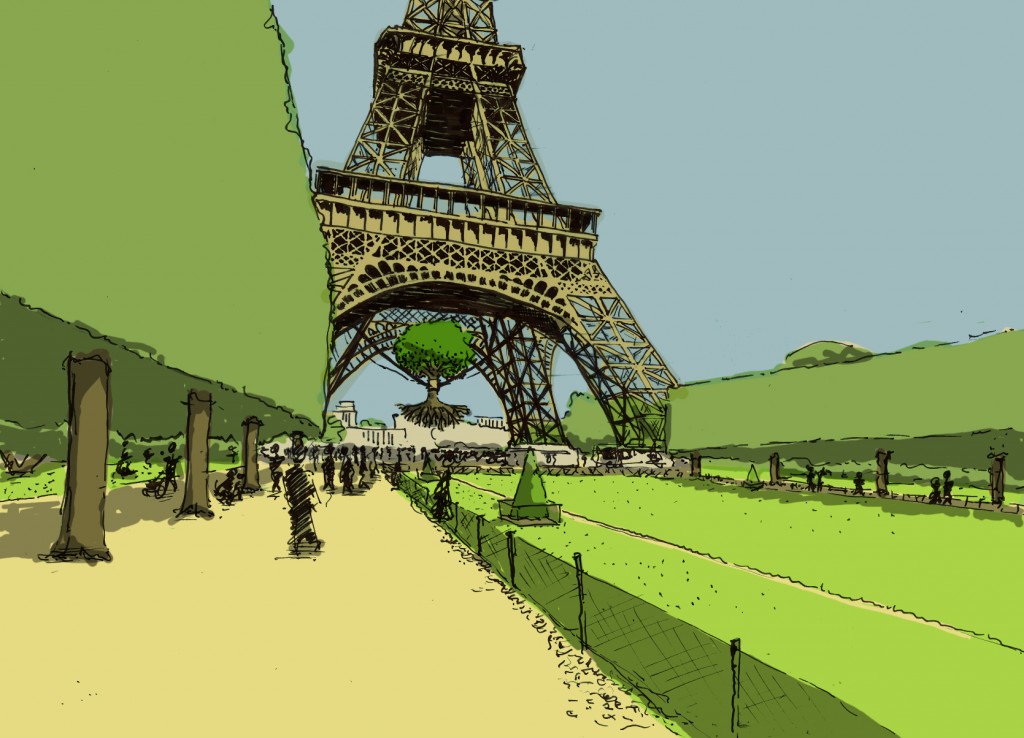I wish to hang a giant, flourishing tree with its roots exposed, under the Eiffel Tower as a sign of the times. The uprooted tree refers to our state of uprootedness and our changed relationship to nature. > more under.
The installation
The contrast and relationship between the colossal tower of pure steel and the living tree, invites the viewer to wonder and reflect. The tree is hung in chains under the giant tower, almost surrounded by it. Protected? Captive?
The tree is hanging high above us, creating a sense of awe, as if looking at something sacred. A temple of nature. At the same time it is hanging under something much greater, chained up, alone and isolated from its environment. The tree is kept alive artificially with an irrigation installation.
We see the contrast of two objects, one living and one lifeless. One represents the magic of the natural, the other the magic of technology. One seems vulnerable and impermanent, the other indestructable. Yet the Eiffel tower has only existed for 120 years, and nature will always be there.
Historical context.
The Eiffel tower was built for the 1889 World Exhibition, and can be seen as a symbol for a time when technology replaced magic. With its rough steel design it represents the first era in the age of industrialisation. Industrialisation radically changed our relationship and way of thinking about nature. No longer did we live from one harvest to the next, depending on what nature had in store for us that year. No longer was travelling at sea a life-threatening experience. From vulnerable wooden ships, dependent on wind, we moved to huge steel ships, that could dominate the oceans and take us anywhere in a predictable timespan. With industrialisation, the age of extraction began, both in the sense of material and energy. Instead of depending on what came from above – the sun, the rain, we started focussing on what was under us. Our dependency decreased, our dominance over nature grew ever more. Until we came to the current point where nature is rather seen as a victim, as something vulnerable, a child almost – something that should be taken care of. This we can see in the tree’s vulnerable position: it is depending on our grace to live or die. The work seeks contrast between the time when the trees were sacred – and when we were praying the weather gods for mercy – and modern days, when we have become the Gods, and nature seems at our mercy. Were we small once, fearsome of nature and its gods – look now, look at our buildings, our creations stand tall and high above the natural. From the first glass plateau of the tower we will be able to look down at the tree as gods.
Collective state of uprootedness.
After a busy day at the office, hours behind the screen, interspersed with meetings – long lists of emails awaiting replies, things to do and remember accumulating in your brain, short conversations in-between, and online chats – we often feel as though we were (are) floating. Our heads pressed full of information, our eyes tired of watching the screen, our body stiff, if we still feel it at all. Anxious and tired at the same time.
How different do we feel after a day of hiking, working in the garden or building a house?
Almost everybody in the modern world recognises this contrast and still it receives so little attention. It is so commonplace, that we have lost sight of it. During many of our activities we don’t even experience ‘nature’ in its most basic sense: weight, texture, scent or any kind of bodiliness. We have migrated to a world where all this is absent. A bodiless world, where our minds bounce and wander around and often barely find the way back to our bodies. Our roots have lost touch with the ground – we are floating.
Often our state of mind or how we feel, is seen as a personal – psychological – issue. But are we not inheritors of a collective history? Do we not share common experiences? Is this state of uprootedness not a collective experience? I think so,and therefore it’s something we could collectively express through this Uprooted Tree.

